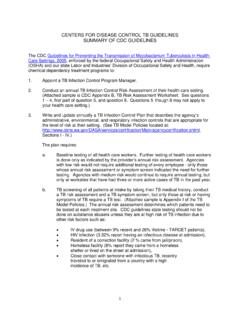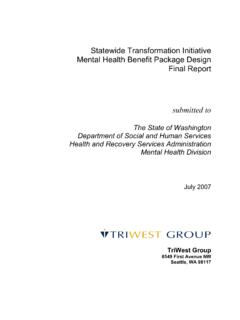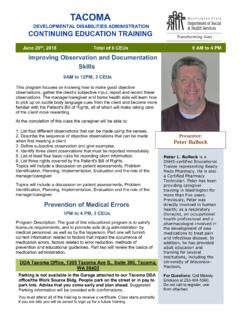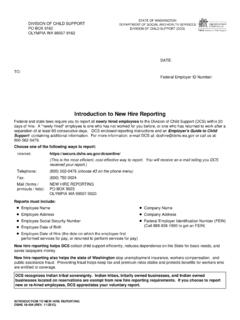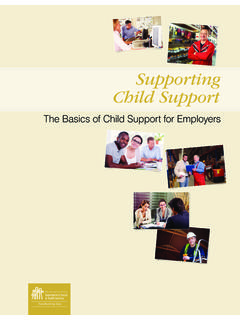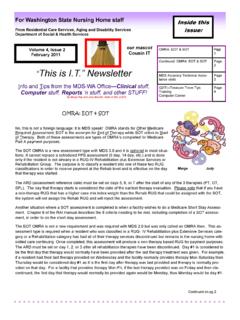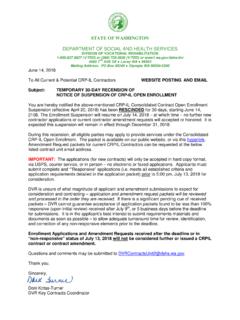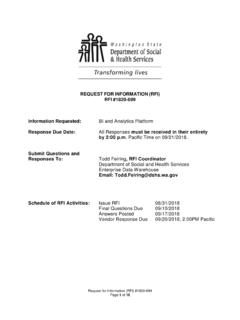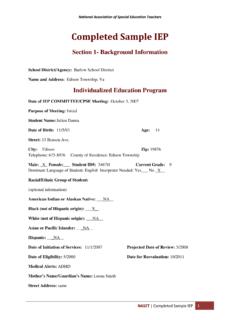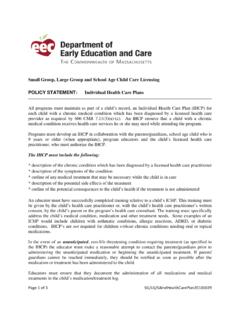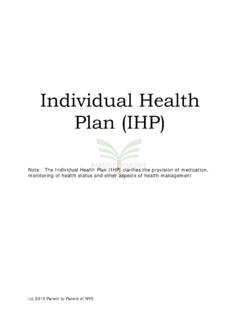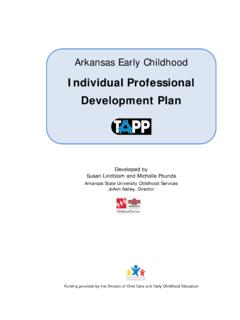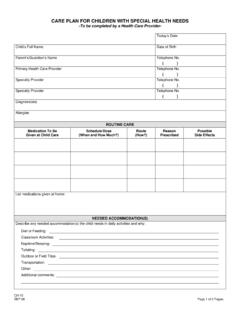Transcription of Guide to support an Individual’s employment Goals
1 DSHS DIVISION OF BEHAVIORAL HEALTH AND RECOVERY Guide TO support AN INDIVIDUAL S employment Goals DSHS Division of Behavioral Health and Recovery March 2012 Page 1 This document is designed as guidance on providing elements of employment supports under the Washington State Rehabilitation Option of Medicaid 1915 (b) Waiver for people with serious mental illness. It is intended to assist workers in providing assistance and identifying billable activities related to supporting individuals in their pursuit of employment Goals . The strategic plan for the Washington State Division of Behavioral Health and Recovery sets a goal to increase the number of consumers showing positive outcomes in the areas of: employment , independent living, social connectedness, and substance use.
2 (DSHS Health and Recovery Services Administration Strategic plan 2009-2013, June 13, 2008) employment provides individuals meaningful daily activities so they feel productive, useful and successful. It allows them to earn money so they are not further disabled by poverty. It is also a place where they can develop relationships. Community Mental Health Agencies are encouraged to have a continuing focus on employment as a real and normal goal in the rehabilitations process. According to the Center for Medicare and Medicaid Services Information Bulletin dated September 16, 2011, work is a fundamental part of adult life for people with and without disabilities. It provides a sense of purpose, shaping who we are and how we fit into our community.
3 Meaningful work has also been associated with positive physical and mental health benefits and is a part of building a healthy lifestyle as a contributing member of society. Because it is so essential to people s economic self-sufficiency, as well as self-esteem and well-being, people with disabilities and older adults with chronic conditions who want to work should be provided the opportunity and support to work competitively within the general workforce in their pursuit of health, wealth and happiness. All individuals , regardless of disability and age, can work and work optimally with opportunity, training, and support that build on each person s strengths and interests. Individually tailored and preference based job development, training, and support should recognize each person s employability and potential contributions to the labor market.
4 Medicaid Bulletin Medicaid is a program designed to fund medical services. Demonstrating the medical necessity of services is an administrative requirement attached to the development and documentation of an individual plan . The treatment plan should clearly demonstrate the legitimate clinical need, the justification for services provided, and indicate an appropriate response to that need. The clearest and most effective approach in documenting medical necessity is through the creation of a clinically relevant individual plan . Effective development and documentation of these holistic individual plans is both an acquired skill as well as a clinical art. DSHS Division of Behavioral Health and Recovery March 2012 Page 2 The treatment plan : Helps to integrate information about the person, the family and members of the individual s support system(s) as related to clinical needs.
5 Facilitates prioritization of needs, interests, and recovery/rehabilitative Goals . Provides a strategy for managing the complex needs of the individual and describes interventions which are defined by measurable outcomes. Is an ongoing process connecting clinical assessments with targeted service delivery. Progress notes should clearly state activities and interventions that are directly related to the Goals and interventions described in the treatment plan . The Golden Thread The Golden Thread is a term that references the tying together of all the concepts described previously. Each piece of documentation must flow logically from one to another such that someone reviewing the record can see the logic and understand the story you are telling about the individual s treatment and progress.
6 (Colorado Behavioral Health Training Guide ) Medicaid Will Not Pay For: In general, Medicaid will not pay for: 1. Job skill training & coaching for specific job skills and job tasks (For example you are not able to bill for teaching the job functions, , how to work the computer, fryer, phone system, drill press, etc.) 2. Tuition for training programs 3. Supplies and equipment for work (boots, computers, uniforms, etc.) 4. Speeches to Rotary and other community groups seeking employer engagement often referred to as Job Development and marketing. 5. Cold calls to employers for generic job leads Assessment Identify the critical clinical needs of the individual Goals and objectives that address the concerns of the individual Progress towards the identified Goals and objectives Treatment plan reviews and assessment updates DSHS Division of Behavioral Health and Recovery March 2012 Page 3 Excerpt of the Washington State plan under Title XIX of the Social Security Act: Individual Treatment Services: A set of treatment services designed to help a Medicaid enrolled individual attain Goals as prescribed in their individual treatment plan .
7 These services shall be congruent with the age, strengths, and cultural framework of the individual and shall be conducted with the individual, his or her family, or others at the individuals behest who play a direct role in assisting the individual to establish and/or maintain stability in his/her daily life. These services may include, developing the individual s self-care/life skills; monitoring the individual s functioning; counseling and psychotherapy. Services shall be offered at the location preferred by the Medicaid enrolled individual. This service is provided by or under the supervision of a mental health professional. Peer support : Services provided by peer counselors to Medicaid enrolled individuals under the consultation, facilitation or supervision of a mental health professional who understands rehabilitation and recovery.
8 This service provides scheduled activities that promote socialization, recovery, self-advocacy, development of natural supports, and maintenance of community living skills. Consumers actively participate in decision-making and the operation of the programmatic supports. Self-help support groups, telephone support lines, drop-in centers, and sharing the peer counselor s own life experiences related to mental illness will build alliances that enhance the consumer s ability to function in the community. These services may occur at locations where consumers are known to gather ( , churches, parks, community centers, etc.) Drop-in centers are required to maintain a log documenting identification of the consumer including Medicaid eligibility. Services provided by peer counselors to the consumer are noted in the consumers Individualized Service plan which delineates specific Goals that are flexible tailored to the consumer and attempt to utilize community and natural supports.
9 Monthly progress notes document consumer progress relative to Goals identified in the Individualized Service plan , and indicates where treatment Goals have not yet been achieved. Peer Counselors are responsible for the implementation of peer support services. Peer counselors may serve on High Intensity Treatment Teams. Peer support is available daily no more than four hours per day. The ratio for this service is no more than 1:20. Therapeutic Psychoeducation: Informational and experiential services designed to aid Medicaid enrolled individuals , their family members ( , spouse, parents, siblings) and other individuals identified by the individual as a primary natural support , in the management of psychiatric conditions, increased knowledge of mental illnesses and understanding the importance of their individual plan of care.
10 These services are exclusively for the benefit of the Medicaid enrolled individual and are included in the Individual Service plan . The primary goal is to restore lost function and promote reintegration and recovery through knowledge of one s disease, the symptoms, precautions related to decompensation, understanding of the triggers of crisis, crisis planning, community resources, successful interrelations, medication action and interaction, etc. Training and shared information may include brain chemistry and functioning; latest research on mental illness causes and treatments; diagnostics; medication education and DSHS Division of Behavioral Health and Recovery March 2012 Page 4 management; symptom management; behavior management; stress management; crisis management; improving daily living skills; independent living skills; problem-solving skills, etc.
